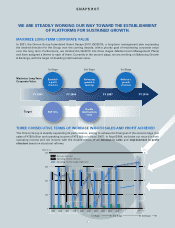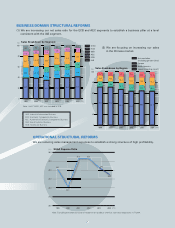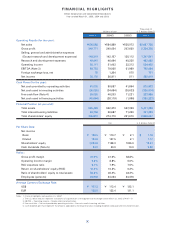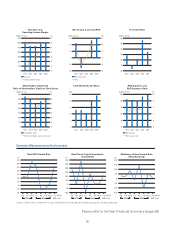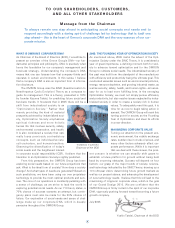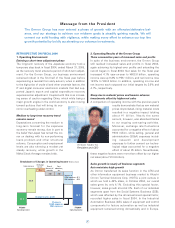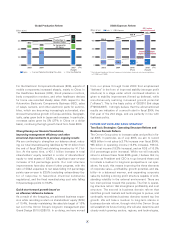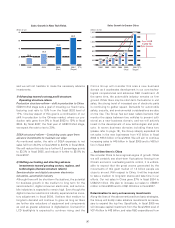Omron 2005 Annual Report Download - page 14
Download and view the complete annual report
Please find page 14 of the 2005 Omron annual report below. You can navigate through the pages in the report by either clicking on the pages listed below, or by using the keyword search tool below to find specific information within the annual report.
The Omron Group seeks to achieve the final goal of GD2010 2nd Stage, doubling our total business value, by
using the four core differentiated technologies we have cultivated during our more than 70 years of experience to
advance the development of new growth domains. In fiscal 2004, our sales results in new business domains
based on new technologies were ¥28.8 billion. We plan to expand this to ¥68 billion by fiscal 2007.
BASIC CONCEPTS BEHIND OUR TECHNOLOGY-DRIVEN
STRATEGY
In order to maintain our competitive superiority and raise
corporate value in the future, the Omron Group will estab-
lish business strategy areas from the standpoint of our core
technologies, and therein set our foundations for top line
growth. This is the idea behind the main theme of GD2010
2nd Stage, “Balancing growth and earnings.” We have also
defined core technologies (see below) as a common aware-
ness of the Omron Group, in an effort to become a
corporate group in which each business increases one
another’s strengths by tapping into a group-wide synergy.
Definition of Core Technologies
1. Technologies that are the source of the Group’s com-
petitive superiority
2. Proprietary technologies that are backed by patents and
expertise, and difficult for our competitors to replicate
3. Technologies that can raise profitability and growth
potential of key businesses through their combination,
and be sustained and strengthened company-wide
through business development
CAPTURING SEVEN BUSINESS DOMAINS THROUGH
FOUR CORE TECHNOLOGIES
The Omron Group’s core technologies start with sensing
and control technology. That is, technology for sensing a
wide range of situations involving people, machines, and
natural phenomena, for extracting and generating valuable
information from this, and for executing control in the
most appropriate form.
Based on the aforementioned technology-driven strat-
egy concept, we have put together a four-point technology
platform that supports sensing and control consisting of: (1)
Ultra-precision 3D fabrication and replication technology as
well as Micro Electro Mechanical Systems (MEMS) technol-
ogy; (2) lightwave control technology; (3) sensing technology
(vision sensing technology, lightwave sensing technology,
and radio wave sensing technology); and (4) knowledge and
information technology. We also believe that we should
combine these proprietary technologies, and aggressively
introduce our management resources in our unrivaled com-
bined technology domains. Therefore, focusing attention on
synergy between (1) and (2), and between (3) and (4), we are
looking to capture domains in the six areas of optical display
devices, optical communications devices, MEMS, in-vehicle,
Quality Lifecycle Management (QLM), and Radio Frequency
Identification (RFID), as well as a seventh—new energy—
through alliances with other companies.
TWO GROWTH DOMAINS WITH GREAT TECHNOLOGI-
CAL SYNERGY
(1) Synergy between ultra-precision 3D fabrication and
replication technology/MEMS technology, and light-
wave control technology
Ultra-precision 3D fabrication and replication technology is a
manufacturing technology that combines master, electrotyp-
ing, reproduction, and materials technologies to realize
microminiaturization and mass production of electronic
devices. MEMS technology is a means of manufacturing
micromachine devices. The Omron Group participated in the
“R&D of Micromachine Technology” national project that
began as a 10-year project in 1991, and was also one of the
earliest MEMS researchers. As a result, the Omron Group is
continually developing next-generation products, including
the world’s smallest and most precise micro-sensors. At the
same time, we possess the world’s top-class technologies in
the area of lightwave control technology, which controls the
direction of light and brings out maximum properties of light
such as brightness, speed, and energy. We are applying
these technologies in areas such as optical display devices
and optical communications devices.
(2) Synergy between vision, lightwave, and radio wave
sensing technologies, and knowledge and informa-
tion control technology
Vision sensing technology uses visual data to give human
visual functions to machines. Lightwave and radio wave
sensing technology utilizes the property of waves that pass
through and reflect off physical objects. Knowledge and
information control technology produces an “intellect” that
allows machines to extract valuable information from infor-
mation obtained by sensors, learn (accumulate data), and
make inferences. In particular, the Omron Group holds a
large number of world-class basic patents in the area of
fuzzy logic, which is the basis of knowledge and information
control technology. Areas in which we are applying these
technologies include next-generation base inspection sys-
tems, facial recognition devices, and driving safety systems.
Four Core Technologies and Seven New Growth Domains
MEMS
RFID
QLM
Optical
communications
devices
In-vehicle
Power electronics
technology
Energy
Ultra-precision 3D fabrication
and replication technology
MEMS technology
Vision sensing technology
Lightwave sensing technology
Radio wave sensing technology
Lightwave control technology
Knowledge and information
control technology
Optical
display
devices
12


